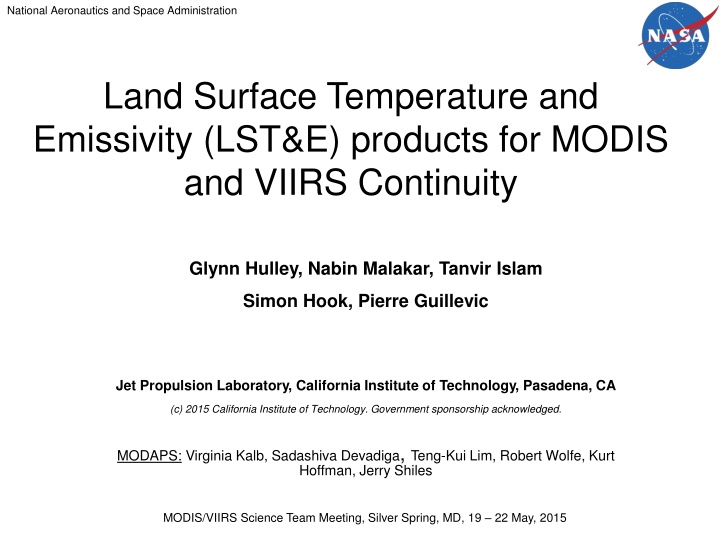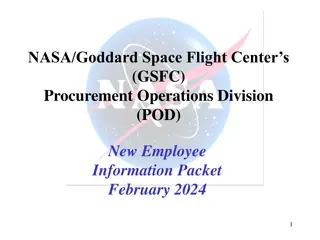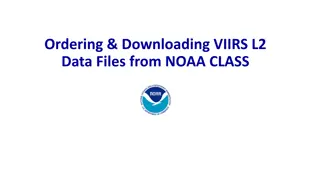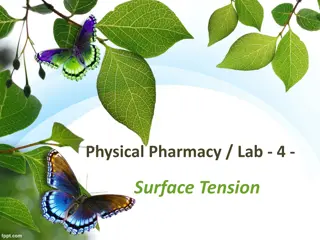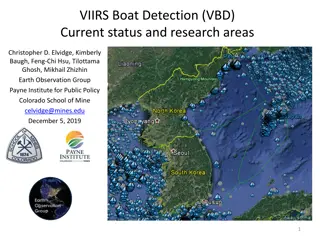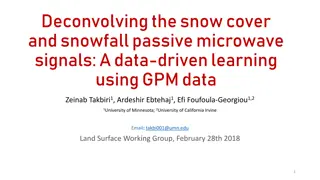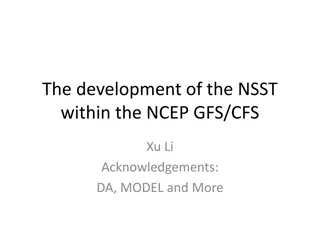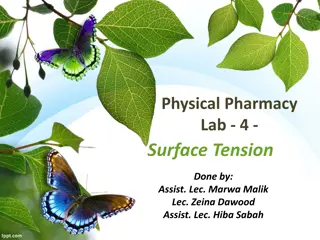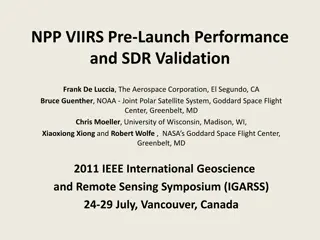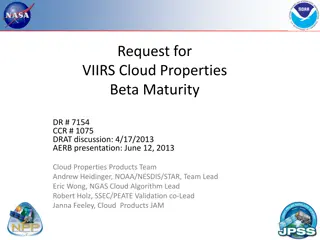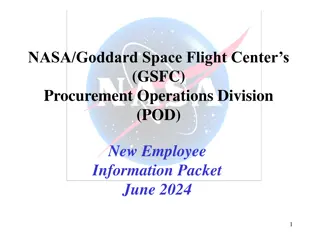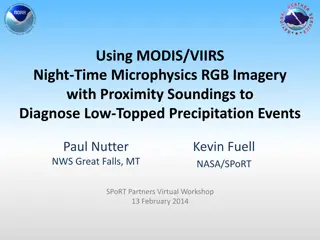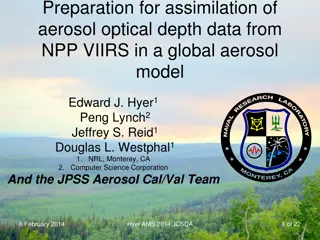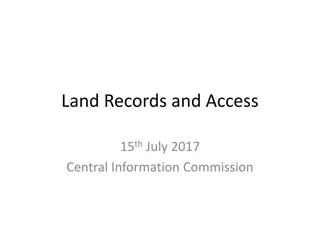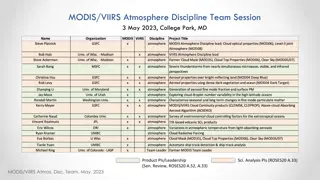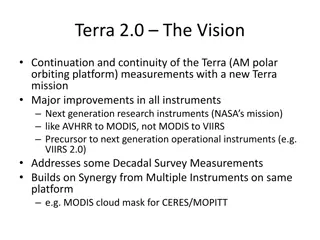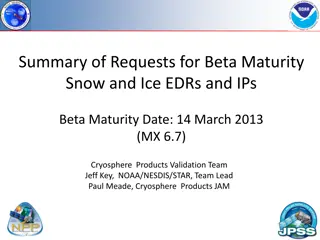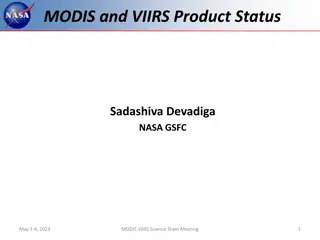NASA MODIS and VIIRS Land Surface Temperature and Emissivity Products Overview
Explore NASA's MODIS and VIIRS continuity products for monitoring land surface temperature and emissivity. Learn about MODIS/VIIRS LST&E updates, new VIIRS products, and the MODIS-VIIRS continuity effort. Dive into error dependencies, algorithms, band emissivity, and uncertainty estimates provided by MODAPS and JPL.
Download Presentation

Please find below an Image/Link to download the presentation.
The content on the website is provided AS IS for your information and personal use only. It may not be sold, licensed, or shared on other websites without obtaining consent from the author.If you encounter any issues during the download, it is possible that the publisher has removed the file from their server.
You are allowed to download the files provided on this website for personal or commercial use, subject to the condition that they are used lawfully. All files are the property of their respective owners.
The content on the website is provided AS IS for your information and personal use only. It may not be sold, licensed, or shared on other websites without obtaining consent from the author.
E N D
Presentation Transcript
National Aeronautics and Space Administration Land Surface Temperature and Emissivity (LST&E) products for MODIS and VIIRS Continuity Glynn Hulley, Nabin Malakar, Tanvir Islam Simon Hook, Pierre Guillevic Jet Propulsion Laboratory, California Institute of Technology, Pasadena, CA (c) 2015 California Institute of Technology. Government sponsorship acknowledged. MODAPS: Virginia Kalb, Sadashiva Devadiga, Teng-Kui Lim, Robert Wolfe, Kurt Hoffman, Jerry Shiles MODIS/VIIRS Science Team Meeting, Silver Spring, MD, 19 22 May, 2015
Outline 1. MOD21 LST&E Product 2. MOD21 LST&E Updates 3. New NASA VIIRS LST&E Product 4. MODIS-VIIRS Continuity
Current Current MODIS/VIIRS MODIS/VIIRS LST&E Products LST&E Products Core Products Status Spatial Formats Algorithm SDS MOD11 (C4, 5, 6*) Collection 6 in processing 1-km L2 Swath, L2G 2X Daily Generalized Split Window (GSW) Wan et al. 1996, 2008 - LST MOD11B1 (C4, 4.1, 5) ? 5-km (C4*) 6-km (C5) Sinusoidal 2X Daily Day/Night Algorithm Wan and Li, 1997 - LST - Emissivity bands 20-23, 29, 31, 32 VIIRS VLST (IDPS) Mx8* 750 m L2 Swath, L2G 2X Daily Single Split-Window Yu et al. 2005 - LST New MODIS/VIIRS LST&E Products (JPL) New MODIS/VIIRS LST&E Products (JPL) New Products Status Spatial Formats Algorithm SDS MODIS-TES (MOD21 C6) Final testing, released with Collection 6 (Tier-2) 1-km L2 Swath, L2G 2X Daily Temperature Emissivity Separation (TES) - LST - Emissivity bands 29, 31, 32 L3G Monthly VIIRS-TES Under production at JPL (Algorithm delivery First quarter 2016) 750 m L2 Swath, L2G 2X Daily Temperature Emissivity Separation (TES) - LST - Emissivity bands 14, 15, 16 L3G Monthly
LST/Emissivity Error Dependency LST/Emissivity Error Dependency Overestimation of emissivity leads to underestimation of LST and vice versa. Split-window (11-12 micron) fixes emissivity based on land cover classification (IGBP) TES physically retrieves emissivity and temperature (minimum 3 bands) MOD11 emissivity too high (2%) MOD21 (TES) 0.5% too high Great Sands National Park In Situ LST
MOD21 MOD21 LST LST Generated using prototype MOD21 algorithm at MODAPS
MOD21 MOD21 Band 29 Emissivity Band 29 Emissivity Generated using prototype MOD21 algorithm at MODAPS
MOD21 C6 LST&E Uncertainty estimates MOD21 C6 LST&E Uncertainty estimates ROSES 2009: Earth System Data Records Uncertainty Analysis LST LST Emissivity Emissivity LST LST Emissivity Emissivity
Outline 1. MOD21 LST&E Product 2. MOD21 LST&E Updates 3. New NASA VIIRS LST&E Product 4. MODIS-VIIRS Continuity
MOD21 Updates and Refinements Parameter MOD21 (JPL v2) MOD21 (JPL v5) (C6) Radiative Transfer Model MODTRAN (MOD07 at 25 km) RTTOV (MOD07 at 5 km) Water Vapor Scaling (WVS) coefficients V2 V5 (day/night and view angle dependent) TES algorithm One calibration for all surfaces Two calibrations for Graybody and Bare surface types
Problem Case: Very humid/warm conditions Precipitable Precipitable Water Vapor Water Vapor MYD07 MYD07 Summertime monsoonal conditions Summertime monsoonal conditions
MODTRAN Atmospheric Correction Degraded MOD07 C6 Resolution (25 km) Temperatures overestimated in very humid conditions! Temperatures overestimated in very humid conditions!
RTTOV Atmospheric Correction Full MOD07 C6 Resolution (5 km) Improved with RTTOV Implementation
LST&E Validation Sites (Stage 1) Redwood Texas Grassland
Land Surface Temperature RMSE (K) 2003-2005 MOD21(V2) MOD21(V5) 2.00 ? MOD21(v2) total = 1.21 K MOD21(v5) total = 1.02 K 1.79 1.80 1.62 1.60 1.50 1.48 1.38 1.40 1.25 1.24 1.22 1.21 1.16 1.20 0.98 0.95 1.00 0.88 0.79 0.80 0.71 0.67 0.64 0.56 0.60 0.49 0.45 0.40 0.20 0.00 Algodones Great Sands Kelso Killpecker Little Sahara White Sands RedWood Txgrass SaltonSea Tahoe
Land Surface Temperature RMSE (K) 2003-2005 MOD21 MOD11 (C5) MOD11 cold bias over Barren sites (3-4 K) 4.50 4.01 4.00 3.83 3.81 3.50 3.13 Comparable accuracy over water, vegetation (1 K) 3.00 2.71 2.50 2.00 1.79 1.50 1.38 1.50 1.23 1.16 1.02 0.98 0.95 0.88 1.00 0.87 0.67 0.64 0.49 0.49 0.45 0.50 0.00 Algodones Great Sands Kelso Killpecker Little SaharaWhite Sands RedWood Txgrass SaltonSea Tahoe
Outline 1. MOD21 LST&E Product 2. MOD21 LST&E Updates 3. New NASA VIIRS LST&E Product 4. MODIS-VIIRS Continuity
NASA VIIRS/MODIS Products LST&E Product Characteristics MOD21 (C6) VIIRS-TES Temperature Emissivity Separation (TES) Temperature Emissivity Separation (TES) Algorithm 29 (8.55 m) 31 (11 m) 32 (12 m) 14 (8.55 m) 15 (10.76 m) 16 (12 m) Bands used RTTOV RTTOV Radiative Transfer Model Primary difference MOD07 C6 MERRA, NUCAPS? ECMWF?, NCEP? Atmospheric Profiles (T, RH) C++/Matlab C++/Matlab Algorithm Software L2, L2G Daily (1 km) L3 8-day, (1 km) L3 Monthly (0.05 ) L2, L2G Daily (750 m) L3 8-day, (1 km) L3 Monthly (0.05 ) Data Product Types - LST - Emissivity (bands 29, 31, 32) - LST - Emissivity (bands 14, 15, 16) Science Data Products
Prototype VIIRS-TES LST&E Retrieval: Sahel-Sahara test granule
VIIRS M14 (8.55 micron) Emissivity First use of VIIRS M14 other than cloud mask, RGB s? Past Studies have shown 8.55 micron emissivity useful for: Land Degradation (desertification) monitoring e.g. French et al. 2008, Hulley et al. 2012 Soil Moisture relationships e.g. Mira et al. 2007, Hulley et al. 2009, Masiello et al. 2013 Land cover, land use change e.g. French et al. 2008, French et al. 2012
VIIRS Emissivity Validation (2014 data)
VIIRS LST Validation Site NWP Model Bias (K) RMSE (K) Lake Tahoe (2014) ECMWF -0.14 1.06 MERRA -0.13 1.15 NCEP -0.23 1.13
Outline 1. MOD21 LST&E Product 2. MOD21 LST&E Updates 3. New NASA VIIRS LST&E Product 4. MODIS-VIIRS LST&E Continuity?
MODIS/VIIRS Split-window Continuity (current) Egypt Large discrepancy mostly due to inconsistent emissivity correction
MODIS/VIIRS TES Continuity (planned) Egypt Very good agreement. Gives confidence in future continuity of LST time series
Future Goal(s): 1. Reduce total number of standard LST products for VIIRS/MODIS (currently 3 different MODIS LST!). 2. Generate Unified products for MODIS and VIIRS standard LST products using uncertainty analysis approach. 3. Evaluate MOD/MYD11 C6 LST Unified MODIS LST: Merge MOD11 and MOD21 products (Aqua and Terra) MEaSURES Project Objective (2016) Unified VIIRS LST: Merge VLST (IDPS) and VIIRS-TES products** ** Contingent upon characterization of VLST Uncertainty ROSES VIIRS Projective Objective (2017)
National Aeronautics and Space Administration Jet Propulsion Laboratory California Institute of Technology Pasadena, California www.nasa.gov
MODIS LST&E Heritage MODIS LST Products Dimensions Spatial Resolution Temporal Resolution Algorithm Output Products MOD11 2030 lines 1354 pixels/line 1 km at nadir Swath 2x daily Split-Window - LST MOD11B1 200 rows 200 columns ~5 km (C4) ~6 km (C5) Sinusoidal 2x daily Day/Night - LST - Emissivity (bands 20-23, 29, 31,32) MOD21 (Collection 6) 2030 lines 1354 pixels/line 1 km at nadir Swath 2x daily 8-day Temperature Emissivity Separation (TES) - LST - Emissivity (bands 29, 31, 32) Why MOD21? Consistent LST accuracy across all surfaces Higher spatial resolution dynamic emissivity (1-km) **Current plan is to merge MOD21/MOD11 using Uncertainty Analysis (MEaSUREs) VIIRS LST&E (Hulley)
MOD21 Science Data Sets Well characterized uncertainties!
MOD21 QC MOD21 has well defined Quality Control (QC) parameters based on TES algorithm outputs
JPLLST&E Validation Sites Site name Site type SURFRAD SURFRAD SURFRAD SURFRAD SURFRAD SURFRAD SURFRAD PI Sand dune PI Sand dune PI Sand dune PI Sand dune PI Sand dune PI Sand dune PI Sand dune PI Sand dune PI Sand dune PI Sand dune Graybody Graybody Graybody EOS Cal/Val EOS Cal/Val LSA-SAF LSA-SAF LSA-SAF Lat Lon Elevation (km) 0.213 1.689 0.634 0.098 0.376 1 0.473 0.094 1.78 2.56 0.8 2 1.56 0 1.216 0.828 0.917 0.796 1.28 0 1.9 0 0.408 0.09 0.016 Emissivity source ASTER (NAALSED) ASTER (NAALSED) ASTER (NAALSED) ASTER (NAALSED) ASTER (NAALSED) ASTER (NAALSED) ASTER (NAALSED) In situ/Lab In situ/Lab In situ/Lab In situ/Lab In situ/Lab In situ/Lab In situ/Lab In situ/Lab In situ/Lab In situ/Lab ASTER speclib In situ (Wan) ASTER speclib ASTER speclib ASTER speclib In situ/Box Method Lab endmember fraction Lab endmember fraction IGBP cover type (MOD12) Cropland Grassland Grassland Cropland/Natural Vegetation 8.04 Cropland/Natural Vegetation 8.04 Shrublands Cropland Bare Bare Bare Bare Bare Bare Bare Bare Bare Shrublands Evergreen Needleleaf forest Grassland Snow and Ice Water Water Bare Grassland Savannas IGBP fraction (%) 7.13 5.87 5.87 Data availability 1994-present 1995-present 1994-present 1994-present 1998-present 1998-present 2003-present n/a n/a n/a n/a n/a n/a n/a n/a n/a n/a n/a n/a n/a 2000-present 2008-present 2008-present 2009-present 2008-present Bondville, IL Boulder, CO Fort Peck, MT Goodwin Creek, MS Penn State, PA Desert Rock, NV Sioux Falls, SD Algodones, CA Coral Pink, UT Great Sands, CO Kelso, CA Killpecker, WY Little Sahara, UT Stovepipe Wells, CA White Sands, NM Namib desert, Namibia Kalahari desert, Botswana Redwood, CA Texas Grassland, TX Greenland Tahoe, CA Salton Sea, CA Gobabeb, Namibia Dahra, Senegal Evora, Portugal 40.05 N 40.12 N 48.31 N 34.25 N 40.72 N 36.63 N 43.73 N 32.95 N 37.04 N 37.77 N 34.91 N 41.98 N 39.7 N 36.62 N 32.89 N 24.45 S 27.325 S 41.4 N 36.29 N 70 N 39.153 N 120 W 33.248 N 115.725 W 23.55 S 15.34 N 38.9 N 88.37 W 105.24 W 105.10 W 89.87 W 77.93 W 116.02 W 96.62 W 115.07 W 112.72 W 105.54 W 115.73 W 109.1 W 112.39 W 117.11 W 106.33 W 15.35 E 21.226 E 123.7 W 102.57 W 41 W 17.7 7.13 9.11 9.11 9.11 9.11 9.11 9.11 9.11 9.11 9.11 17.7 4.12 5.87 ~34 tbd tbd 9.11 5.87 4.23 15.05 E 15.49 W 8.00 W SURFRAD = NOAA Surface Radiation Budget Network (http://www.esrl.noaa.gov/gmd/grad/surfrad/index.html) PI Sand dune = Pseudo-invariant sand dune sites (JPL, http://emissivity.jpl.nasa.gov/validation) Graybody = graybody sites used for R-based validation at JPL In situ/Lab = Sand samples collected in the field and measured using a Nicolet spectrometer at JPL during 2008 In situ (Wan) = Surface emissivity measured with a sun-shadow method in Dallam County, Texas in April 2005 by Zhengming Wan 30
MERRA Global Water Vapor (2m) 06hr UTC 12hr UTC Time Interpolated at 11hr VIIRS UTC
Final Transmittance Field Native Grid 11hr UTC Geolocated to VIIRS 11hr UTC Triangulation-based Interpolation
MODIS LST Validation: Great Sands, Colorado ** Radiance-based LST validation using lab-measured sand samples collected at dune site
MODIS Emissivity Validation: Great Sands, Colorado MOD11 classification set too high resulting in cold LST bias (>2-5 K)
MOD21/MOD11 LST Validation summary: Graybody surfaces (forest, snow/ice, grassland) Aqua Day Aqua Night MOD11 MOD21 MOD11 MOD21 Redwood Forest, CA 41.4 N, 123.7 W 0.32 -0.34 0.19 -0.61 Bias [K] RMSE [K] 0.56 0.61 0.60 0.96 Greenland 70 N, 41 W 0.61 -0.33 0.34 -0.18 Bias [K] RMSE [K] 0.73 0.50 0.56 0.35 Texas Grassland 36.29 N, 102.57 W 0.59 0.24 0.66 0.59 Bias [K] RMSE [K] 0.85 0.54 1.02 0.98 MOD21 and MOD11 have similar accuracy over graybody surfaces (<1 K)
MOD21/MOD11 LST Validation summary: Bare surfaces (pseudo-invariant sand sites) MOD11 MOD21 MOD11 MOD21 Sites Obs Bias (K) RMSE (K) Algodones, CA 956 -2.89 -0.05 3.04 1.07 Great Sands, CO 546 -4.53 -0.93 4.63 1.17 Kelso, CA 759 -4.55 -1.48 4.62 1.67 Killpecker, WY 463 -4.51 -1.19 4.58 1.42 Little Sahara, UT 670 -3.71 -0.60 3.79 0.89 White Sands, NM 742 -0.73 -0.29 1.07 0.95 MOD11 C5 cold bias of up to ~5 K over bare sites (due to overestimated classification emissivity)
Future Work and Summary MOD21 PGE in final stages of testing and development in preparation for Collection 6 Reprocessing of MODIS Terra/Aqua to begin May/June Development and optimization of MOD21 algorithm will continue under NASA TERAQ award from 2014-2016 MOD21 LST&E products are physically retrieved with TES algorithm resulting in similar accuracy (<1.5 K) over all land cover types and a dynamic spectral emissivity product for detection and monitoring of landscape changes A unified MOD21/MOD11 LST product is in production for a NASA MEaSUREs project at JPL
Theoretical Basis: Planck Function c B = 100 1 c Radiance (W/m*m*m)/1.0e6 Thermal Infrared (TIR) 450K 5 80 exp 1 2 sT 60 40 = 1 350K Ts B 20 273.15K 0 4 6 8 Wavelength (micrometers) 10 12 14 16 18 20 where B : = blackbody spectral radiance = wavelength Surface = Temperatur e sT c first = radiation constant 1 As the temperature increases the peak in the Planck function shifts to shorter and shorter wavelengths c second = radiation constant 2
Temperature/Emissivity retrieval algorithms To solve the under-determined temperature-emissivity problem: N spectral measurements (N radiances) with N + 1 unknowns (N emissivity, 1 Temperature) 1. Split window approach Requires 2 bands Prescribed spectral emissivity Regression coefficients should represent all configurations (atmospheric water content, view angle, surface Tair, ) 2. Temperature-Emissivity Separation (TES) ASTER approach TES Calibration Curve Multispectral (minimum 3 bands) Requires atmospheric profiles for full atmospheric correction with Radiative Transfer Model Based on Emissivity model (Calibration Curve) 40
Spectral Emissivity ( lackbody L B ) L ( Material) Emissivity: ratio of the spectral radiance of a material to that of a blackbody at the same temperature: L ( Material) = L ( Blackbody) L = Spectral Radiance 42
Test Code Implementation VIIRS TES Processing Steps Evaluation Read L1B and Cloud Mask Data (Fill radiances bowtie) NWP atmospheric data (read, geolocate, interpolate) Run RTTOV Radiative Transfer Test NWP Accuracy (ECMWF, MERRA, NCEP) In progress Implement Water Vapor Scaling (WVS) Model Temperature Emissivity Separation (TES) Validation In progress
